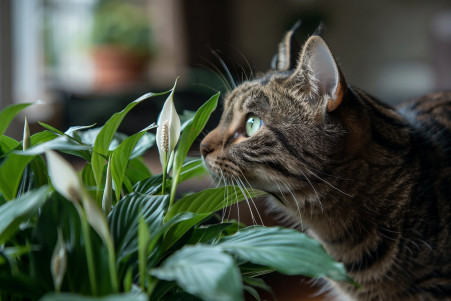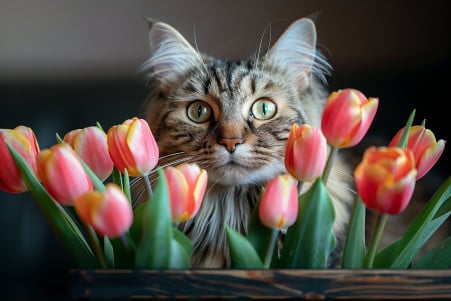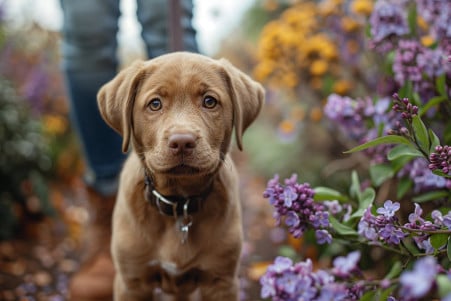Can Cats Eat Lilacs? What You Need to Know About Plant Toxicity
5 March 2024 • Updated 4 March 2024

Cat parents are always concerned about their fur babies’ well-being, and that includes knowing whether or not certain plants are toxic, like lilacs. While common lilacs (Syringa vulgaris) are safe and non-toxic for cats, Persian lilacs (Melia azedarach) are considered poisonous and can cause symptoms such as vomiting and seizures.
It’s important to be able to tell the difference between these two types of lilacs to keep your cat out of harm’s way.
In this article, we’ll dive into the scientific literature on plant toxicity, including botany research and clinical studies, to explain the impact of different lilac species on cats. We’ll also look at the chemical compounds in these plants and clinical reports of cats that have been exposed to them to provide a comprehensive understanding of which lilacs are toxic to cats and how to avoid and treat potential toxicity.
Are lilacs poisonous to cats?
Know the Risk: Persian Lilac and Cats
While the blooming of common lilacs signals the arrival of spring, not all lilacs are created equal. The Persian lilac, also known by its scientific name Melia azedarach, is notable for being a toxic plant that poses a real danger to cats. According to Pet Keen, Persian lilacs contain Tetranortriterpenes, or meliatoxins, which are neurotoxic and especially dangerous to cats.
If cats eat Persian lilac, they can experience symptoms like excessive drooling, vomiting, diarrhea, and in more severe cases, depression, weakness, and seizures, warns Cat Care Checklist. This is an emergency situation, and if you think your cat has ingested any part of a Persian lilac, you need to get them to the vet right away.
According to Cat Vet Info, symptoms can be as mild as an upset stomach or as severe as seizures.
Knowing is half the battle. By learning about the toxicity of Persian lilac and understanding the symptoms of poisoning, cat owners can work to keep their pets safe. This not only helps keep our pets out of harm’s way but also gives us peace of mind as we work to keep our cats safe.
Keeping Cats Safe with Safe Lilac Varieties
Although the Persian lilac is dangerous to cats, cat parents can rest easy knowing that the common lilac (Syringa vulgaris) is safe for their furry friends. In fact, none of the more than 30 species of lilacs in the Syringa genus, including the common lilac, have been shown to be toxic to cats, according to Hepper.
Still, large amounts of common lilac berries and flowers could cause some mild stomach upset, such as vomiting and diarrhea, according to Daily Paws.
It’s important to be able to tell the difference between the non-toxic common lilac and its toxic relatives. The common lilac has bright purple flowers and is a member of the Syringa genus, while the toxic Persian lilac, also known as the chinaberry tree, is a member of the Melia genus and has small yellow berries.
To make sure your cat is safe, choose non-toxic plants and make sure any lilac in your yard or home is a member of the Syringa genus. This way, you can avoid any accidental exposure to toxic plants, according to Plant Addicts.
By making sure that the plants in our homes and yards are safe for our cats and being aware of the dangers that some plants can pose, we can make sure that our cats are safe. With a carefully chosen selection of non-toxic plants and some careful supervision, cat parents can make sure that their cats are safe and happy.
Vet Insights: Lilacs and Cat Health
Clinical reports of Persian lilac toxicity in cats highlight the importance of immediate veterinary care. Clinical signs of Persian lilac ingestion can appear in cats quickly, from a few hours to a few days, and can include vomiting, diarrhea, and even severe neurological symptoms like tremors and seizures, according to Pet Keen.
In response, veterinarians will decontaminate the cat and provide symptomatic care, underlining the importance of acting fast to reduce the impact of the toxin.
For example, in one case described by Catster, a cat was brought to the vet with acute symptoms after ingesting Persian lilac. The vet performed a full physical exam and treated the cat with vomiting induction, activated charcoal, and supportive care. This case demonstrates the importance of quick action on the part of the veterinarian and the cat owner’s ability to recognize the signs of poisoning and seek help immediately.
Veterinarians also have a key role in helping cat owners understand plant toxicity. The ASPCA helps veterinarians and pet owners prevent accidental poisonings by offering a complete list of plants that are toxic to cats. This knowledge can help cat owners make sure their pets are in safe environments and reduce the risk of exposure to toxic plants like Persian lilac.
Understanding the Chemistry of Lilac Toxicity
The toxicity of Persian lilac and other lilac species is due to the chemical composition of the plant. In a paper published in ScienceDirect, researchers found that compounds like syringin and forsythoside B in the bark of common lilac have moderate anti-inflammatory effects in humans. However, the compounds in toxic lilac species are different and can be toxic to cats.
In general, plant toxicity in animals is caused by secondary metabolites, including alkaloids, glycosides, and terpenes. A paper published in PMC explains that plants produce these metabolites as a defense mechanism against predators and other environmental factors.
However, these compounds can be toxic to cats when ingested, causing symptoms like vomiting, seizures, or other more serious toxic reactions. For example, the compounds in Persian lilac can affect the nervous system, leading to symptoms that require immediate medical attention.
It’s important to understand the specific toxicological effects of these compounds on cats. According to PMC, some plants contain toxic proteins like lectins and ribosome-inactivating proteins that can be very toxic when ingested. Knowing the chemical compounds that cause toxicity in lilacs and how they affect cats can help cat owners keep their pets safe.
How to Keep Cats Safe from Lilac and Other Plant Toxins
Cat owners can take several steps to ensure their cats are safe from the potential dangers of toxic plants like Persian lilacs. In addition to following the advice of their veterinarians, The Sill recommends that cat owners remove these plants from their homes or at least keep them in a location that is inaccessible to their pets.
They can also consider cat-friendly options like parlor palms or cat grass, which will let their cats explore their curiosity without putting them in harm’s way.
If a cat does ingest a toxic lilac, it’s important to act quickly. New Hope Animal Hospital urges cat owners to contact their veterinarians immediately, as fast treatment can make a big difference.
If a cat is showing signs of poisoning, such as vomiting, diarrhea, or seizures, it needs to be taken to the vet right away, where it may be treated with methods like vomiting induction or activated charcoal to stop the body from absorbing more toxins.
Because the effects of plant toxicity may not be seen right away, The Healthy Pet Club stresses the importance of being aware and prepared. By learning the signs of poisoning and making sure you have access to professional help, you can save time and possibly your cat’s life. With knowledge and prevention, cat owners can make sure their pets are safe.
Lilacs and Cat Safety: A Recap
In summary, the safety of lilacs for cats depends on the type of lilac. Common lilacs (Syringa vulgaris) are not toxic to cats, so cats can feel free to sniff and rub against these flowers to their hearts’ content, as Hepper confirms.
On the other hand, Persian lilacs (Melia azedarach) are toxic, and if a cat eats them, they can experience vomiting, diarrhea, and seizures, and they will need to be taken to the vet immediately, according to the ASPCA.
Cat parents should always be aware of the plants they have in their homes and gardens. Plant Addicts warns that cat parents should always be on the lookout for toxic plants like Persian lilacs to ensure that their cats don’t eat them. By being aware and on the lookout, cat parents can make sure that their pets are safe and healthy.
Let’s also remember the larger issue of pet safety: a safe environment is a key part of being a good pet parent. Knowing which plants are and aren’t toxic is important for making sure that cats can safely explore their surroundings.


